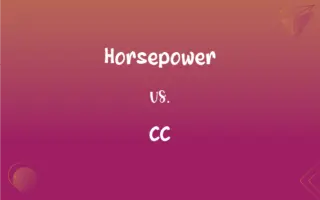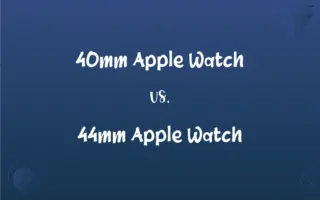Copper 1 vs. Copper 2: What's the Difference?
Edited by Janet White || By Harlon Moss || Published on February 25, 2024
Copper 1 (Cu+) is copper in its +1 oxidation state, often forming colorless or lightly colored compounds, while Copper 2 (Cu2+) is copper in its +2 oxidation state, forming usually blue or green compounds.

Key Differences
Copper 1, also known as cuprous, is the +1 oxidation state of copper, characterized by a single positive charge. Copper 2, or cupric, is the +2 oxidation state with two positive charges, resulting in different chemical and physical properties.
In terms of reactivity, Copper 1 compounds are less stable and reactive compared to Copper 2 compounds, which are more commonly found in nature and used in various applications. Copper 2 compounds are more stable and widely used in industries due to their higher oxidation state.
Copper 1 compounds often have colorless or white appearances, while Copper 2 compounds are known for their distinctive blue or green colors, commonly seen in copper sulfate and copper chloride.
Copper 1 is typically found in limited environments due to its lower stability and can be more difficult to work with in laboratory settings. In contrast, Copper 2 is abundant in nature, found in minerals like azurite and malachite, and is easier to handle.
Copper 1 compounds are used in specialized applications like catalysis and organic synthesis, whereas Copper 2 compounds have broader applications including use in pigments, electroplating, and as a fungicide.
ADVERTISEMENT
Comparison Chart
Oxidation State
+1
+2
Stability
Less stable
More stable
Common Colors
Colorless, white
Blue, green
Reactivity
Less reactive
More reactive
Natural Occurrence
Less common
More abundant
ADVERTISEMENT
Applications
Specialized uses in catalysis, organic synthesis
Used in pigments, electroplating, fungicides
Compounds
Cuprous oxide, cuprous chloride
Copper sulfate, copper chloride
Chemical Behavior
More likely to reduce to metallic copper
More likely to form complex ions
Industrial Use
Less common
More widely used
Environmental Presence
Limited, in specific conditions
Widespread, in various minerals
Copper 1 and Copper 2 Definitions
Copper 1
Copper 1 is the +1 oxidation state of copper, forming compounds like cuprous oxide.
Copper 1 is used in the synthesis of certain organic compounds.
Copper 2
Copper 2 is more likely to form complex ions.
Copper 2 ions form a complex with ammonia in solution.
Copper 1
Copper 1 compounds are less stable and reactive.
Copper 1 chloride is more sensitive to air than its Copper 2 counterpart.
Copper 2
It is widely used in industries for applications like pigments and electroplating.
Copper 2 is utilized in the electroplating process for its excellent conductivity.
Copper 1
Used in specialized applications like catalysis.
Copper 1 ions act as a catalyst in this reaction.
Copper 2
Found abundantly in nature in minerals like azurite and malachite.
The green color of malachite is due to the presence of Copper 2.
Copper 1
It is less commonly found in nature compared to Copper 2.
Copper 1 compounds are rarely found in natural mineral deposits.
Copper 2
Copper 2 compounds are more stable and reactive than Copper 1.
Copper 2 chloride is a stable compound used in various chemical reactions.
Copper 1
It often forms colorless or white compounds.
The solution turned colorless when reduced to Copper 1.
Copper 2
Copper 2 is the +2 oxidation state of copper, commonly forming blue or green compounds.
The blue color of copper sulfate is due to Copper 2.
FAQs
What color are Copper 2 compounds?
Typically blue or green.
Are Copper 1 compounds stable?
Less stable compared to Copper 2 compounds.
What is Copper 1?
Copper in its +1 oxidation state (Cu+).
What color are Copper 1 compounds?
Often colorless or white.
What is Copper 2?
Copper in its +2 oxidation state (Cu2+).
What is an example of a Copper 1 compound?
Cuprous oxide (Cu2O).
Where is Copper 2 commonly found?
In nature, in minerals like azurite and malachite.
What is a common use of Copper 1?
In specialized applications like catalysis and organic synthesis.
What is an example of a Copper 2 compound?
Copper sulfate (CuSO4).
Does Copper 1 have any environmental impact?
It's less common but can have an impact in specific conditions.
Are Copper 2 compounds reactive?
Yes, they are more reactive than Copper 1.
Can Copper 1 be oxidized to Copper 2?
Yes, it can be oxidized to Copper 2.
Where is Copper 1 commonly found?
In specific environments and certain organic compounds.
What is a common use of Copper 2?
In pigments, electroplating, and as a fungicide.
Is Copper 1 used in electroplating?
No, Copper 2 is typically used in electroplating.
How do Copper 1 and Copper 2 differ in chemical reactions?
They differ in reactivity, stability, and the types of compounds they form.
Can Copper 2 be reduced to Copper 1?
Yes, it can be reduced to Copper 1 under certain conditions.
Is Copper 2 found in biological systems?
Yes, it's essential in various biological systems.
Can Copper 1 form complex ions?
Less commonly than Copper 2.
Is Copper 2 toxic?
In high concentrations, it can be toxic.
About Author
Written by
Harlon MossHarlon is a seasoned quality moderator and accomplished content writer for Difference Wiki. An alumnus of the prestigious University of California, he earned his degree in Computer Science. Leveraging his academic background, Harlon brings a meticulous and informed perspective to his work, ensuring content accuracy and excellence.
Edited by
Janet WhiteJanet White has been an esteemed writer and blogger for Difference Wiki. Holding a Master's degree in Science and Medical Journalism from the prestigious Boston University, she has consistently demonstrated her expertise and passion for her field. When she's not immersed in her work, Janet relishes her time exercising, delving into a good book, and cherishing moments with friends and family.
































































